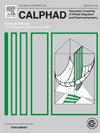XTDB, an XML based format for Calphad databases
IF 1.9
3区 材料科学
Q4 CHEMISTRY, PHYSICAL
Calphad-computer Coupling of Phase Diagrams and Thermochemistry
Pub Date : 2025-07-23
DOI:10.1016/j.calphad.2025.102849
引用次数: 0
Abstract
The calculation of phase diagram (Calphad) method uses models that depend on assessed parameters to describe the thermodynamic properties of materials. These model parameters are assessed by researchers and students using experimental and theoretical data on binary and ternary systems that can be merged to multicomponent databases and used to calculate properties and simulate processes for a wide range of materials.
There are several different software using the Calphad method for calculations and they may use slightly different models and database formats. This paper will provide a short background on the current state of database development and proposes a new format based on the eXtensive Markup Language (XML) as a unified database format. This change is particularly important as several new models for the pure elements are currently being introduced in the Calphad databases.
XTDB,一种基于XML的calphhad数据库格式
相图计算(Calphad)方法使用依赖于评估参数的模型来描述材料的热力学性质。这些模型参数由研究人员和学生使用二元和三元系统的实验和理论数据进行评估,这些数据可以合并到多组分数据库中,用于计算各种材料的性能和模拟过程。有几种不同的软件使用calphhad方法进行计算,它们可能使用略有不同的模型和数据库格式。本文简要介绍了当前数据库发展的背景,并提出了一种基于扩展标记语言(XML)作为统一数据库格式的新格式。这一变化尤其重要,因为目前正在calphhad数据库中引入几个纯元素的新模型。
本文章由计算机程序翻译,如有差异,请以英文原文为准。
求助全文
约1分钟内获得全文
求助全文
来源期刊
CiteScore
4.00
自引率
16.70%
发文量
94
审稿时长
2.5 months
期刊介绍:
The design of industrial processes requires reliable thermodynamic data. CALPHAD (Computer Coupling of Phase Diagrams and Thermochemistry) aims to promote computational thermodynamics through development of models to represent thermodynamic properties for various phases which permit prediction of properties of multicomponent systems from those of binary and ternary subsystems, critical assessment of data and their incorporation into self-consistent databases, development of software to optimize and derive thermodynamic parameters and the development and use of databanks for calculations to improve understanding of various industrial and technological processes. This work is disseminated through the CALPHAD journal and its annual conference.

 求助内容:
求助内容: 应助结果提醒方式:
应助结果提醒方式:


